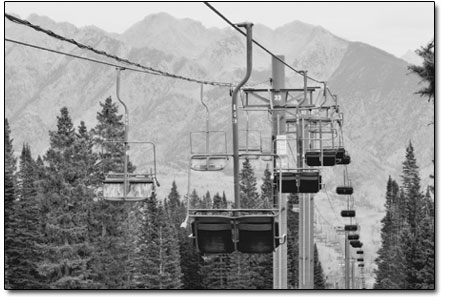|
| ||||
| Mending the mountain SideStory: A new and improved Purg
by Will Sands Conservation and expansion have met halfway at Durango Mountain Resort. After four years of review, the Forest Service recently opened the way for new trails, lifts and on-mountain restaurants at the local ski area. Thanks to the approval and Colorado Wild’s blessing, the first of many major upgrades may be just one more season away. DMR has spent the last four years seeking approval to update its aging master plan, which was last amended in 1979. On Sept. 10, the Forest Service smiled on a variety of upgrades, including lift replacements, terrain expansion and increases in uphill carrying capacity and snowmaking. The improvements will be staged over the next 20 years. In that time, the resort plans to increase its carrying capacity from 6,850 guests per day to 8,840; upgrade three existing lifts and install 10 new lifts; improve four existing trails, add 17 new trails and develop two gladed areas for a total 22 percent increase in the trail network; and increase snowmaking capacity from 215 to 364 acres. As a second component of the master development plan, the resort will create permanent trails for the Nordic Center and summer horse and adaptive trails across U.S. Highway 550 from the ski area. Since the plan was first announced, the public embraced the overdue facelift for Purgatory. However, the changes will also be significant from an environmental perspective, a fact that cemented an ongoing partnership between DMR and Colorado Wild. In recent months, the ski resort and the conservation group have worked together to ensure that the upgrades meet the needs of locals and guests, while also having a limited impact on the natural environment. Last week, Ryan Demmy Bidwell, executive director of Colorado Wild, applauded the cooperative effort and its outcome. “Colorado Wild is pleased with the level of analysis that was done and comfortable with the project moving forward as it has been agreed to,” he said. “It makes sense to upgrade outdated facilities at the resort, and DMR has taken care to address environmental impact issues for the majority of the plan.”
The Ice Creek area is one place where the ski area and Colorado Wild did not see eye-to-eye. DMR proposed creating a beginners’ area at Ice Creek, which adjoins the Twilight and Hermosa Park lift areas. The proposal would have installed lifts, trails and a restaurant along the east side of Hermosa Park and within the headwaters of the East Fork of Hermosa Creek. However, the headwaters are biologically significant, according to Bidwell, and have been identified as critical habitat for the Canada lynx. Based on an agreement between Colorado Wild and DMR, Forest Service approval of the Ice Creek pod will be deferred. During that time, there will be study to identify the most environmentally friendly approach to creating more learn-to-ski terrain at the resort. “I studied the draft environmental impact statement extensively this winter and kept coming back to concerns related to the Ice Creek area improvements,” Bidwell said. “It’s not often our concerns about a ski area improvement plan are as geographically isolated as they are here.” Colorado Wild’s concerns do end at Ice Creek, however, and DMR is taking big steps to lighten the expansion’s impacts elsewhere. In coming years, the resort will undertake initiatives to help reduce and mitigate the environmental impacts of historic logging and grazing that were once permitted within and near the DMR boundary. In addition, the ski area plans to preserve pristine areas on the mountain to offset new winter trails. Steps will also be taken to restore the Purgatory Creek stream channel and install erosion and sediment controls on new trails. The resort also plans to create a lynx mitigation fund, which will provide significant funding for lynx habitat improvements in Southwest Colorado. Gary Derck, DMR’s CEO, noted that these steps are due in part to a longstanding relationship between the ski area and conservation group. In 2002, the two entities surmounted Colorado Wild’s opposition to DMR’s private development plan, when the resort made modifications to address concerns. Derck noted that in the case of the on-mountain improvements, the ongoing partnership means the upgrades can go forward without an appeal or protracted litigation. “We hope that this agreement will demonstrate DMR’s commitment to doing the right thing and to showing how conservation organizations and the ski industry can work together to find mutually beneficial resolutions to allowing mountain improvements that are very much desired by our local and destination customers,” Derck noted.
|



